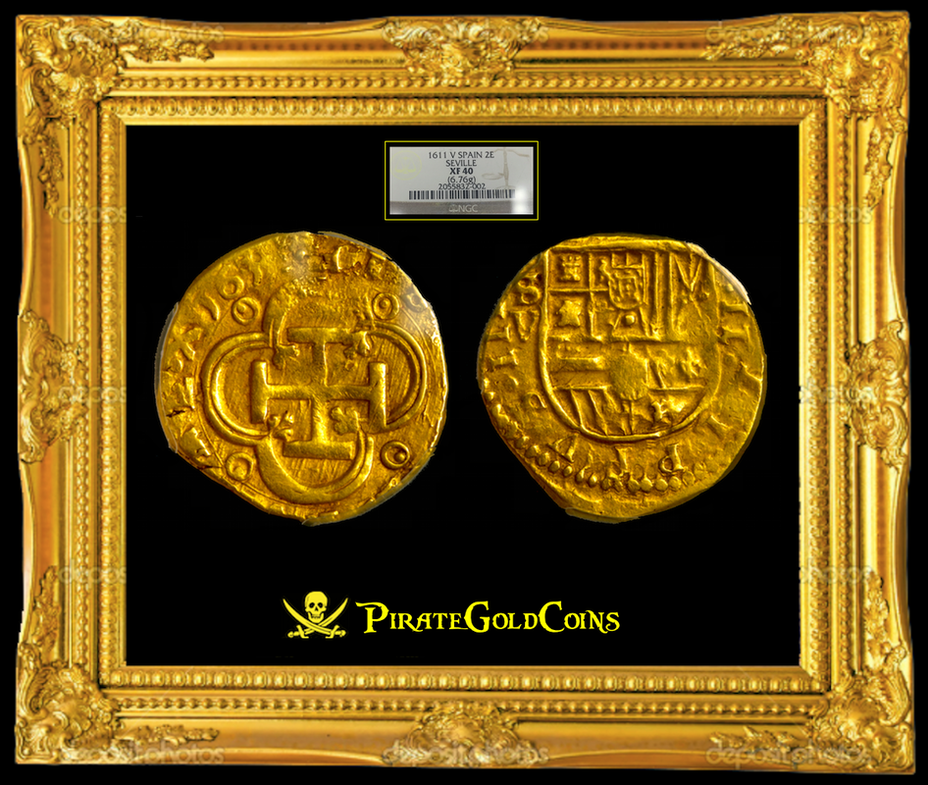SPAIN 2 ESCUDOS 1611 "SEVILLE- DATED" ~ NGC 40 ~ ATOCHA WRECK
SPAIN 2 ESCUDOS DOUBLOON COB 1611 “DATED” NGC 40 ATOCHA SHIPWRECK ERA GOLD
FINEST KNOWN!!! NGC had only graded one prior in VF, this is ONLY the 2nd one to be GRADED! This gorgeous nearly perfectly round cob has the very RARE “DATE” ONE THE CROSS SIDE!!! The PCGS holder is in ERROR, since it shows 1621-65, and CLEARLY you can see it’s a KING Philip III (1578-1621), see below to read more on King Philip III. Also, importantly, the ASSAYER is clearly visible to the left of the Shield “V.” This Assayer was ONLY striking cobs for a three year period between 1611-1613. I’ve also attached the NGC Population report (this was before this piece was Certified and now is the FINEST of ONLY 2 Known!) and the DATED pieces range from 1611-15 for Seville and Assayer “V.” . The details are very strong, especially for over 400 YEARS OLD!!! The Golden Luster is a beautiful butterscotch reflection. Here’s the details on King Philip III:
Philip III was the King of Spain and King of Portugal and the Algarves, where he ruled as Philip II of Portugal from 1598 until his death. Philip III married Margaret of Austria, sister of Emperor Ferdinand II (member of the House of Habsburg. Born in Madrid, the son of Philip II of Spain and his fourth wife (and niece) Anna, he shared the viewpoints and beliefs of his father, including his piety, but did not inherit his industry. The diligent old king hand sorrowfully confessed that God had not given him a son capable of governing his vast dominions, and that he has foreseen that Philip III would be led by his servants. Unlike his father, Philip III was not interested in the day-to-day business of government. He spent many months each year traveling to different palaces with his court, away from the government centre. His household costs rose enormously at a time of falling income. He died in Madrid in 1621. The story told in the memoirs of the French ambassador Bassompierre, that he was killed in the heat of a brasero (a pan of hot charcoal), because the proper official to take it away was not at hand, is a humorous exaggeration of the formal etiquette of the court.
FINEST KNOWN!!! NGC had only graded one prior in VF, this is ONLY the 2nd one to be GRADED! This gorgeous nearly perfectly round cob has the very RARE “DATE” ONE THE CROSS SIDE!!! The PCGS holder is in ERROR, since it shows 1621-65, and CLEARLY you can see it’s a KING Philip III (1578-1621), see below to read more on King Philip III. Also, importantly, the ASSAYER is clearly visible to the left of the Shield “V.” This Assayer was ONLY striking cobs for a three year period between 1611-1613. I’ve also attached the NGC Population report (this was before this piece was Certified and now is the FINEST of ONLY 2 Known!) and the DATED pieces range from 1611-15 for Seville and Assayer “V.” . The details are very strong, especially for over 400 YEARS OLD!!! The Golden Luster is a beautiful butterscotch reflection. Here’s the details on King Philip III:
Philip III was the King of Spain and King of Portugal and the Algarves, where he ruled as Philip II of Portugal from 1598 until his death. Philip III married Margaret of Austria, sister of Emperor Ferdinand II (member of the House of Habsburg. Born in Madrid, the son of Philip II of Spain and his fourth wife (and niece) Anna, he shared the viewpoints and beliefs of his father, including his piety, but did not inherit his industry. The diligent old king hand sorrowfully confessed that God had not given him a son capable of governing his vast dominions, and that he has foreseen that Philip III would be led by his servants. Unlike his father, Philip III was not interested in the day-to-day business of government. He spent many months each year traveling to different palaces with his court, away from the government centre. His household costs rose enormously at a time of falling income. He died in Madrid in 1621. The story told in the memoirs of the French ambassador Bassompierre, that he was killed in the heat of a brasero (a pan of hot charcoal), because the proper official to take it away was not at hand, is a humorous exaggeration of the formal etiquette of the court.







